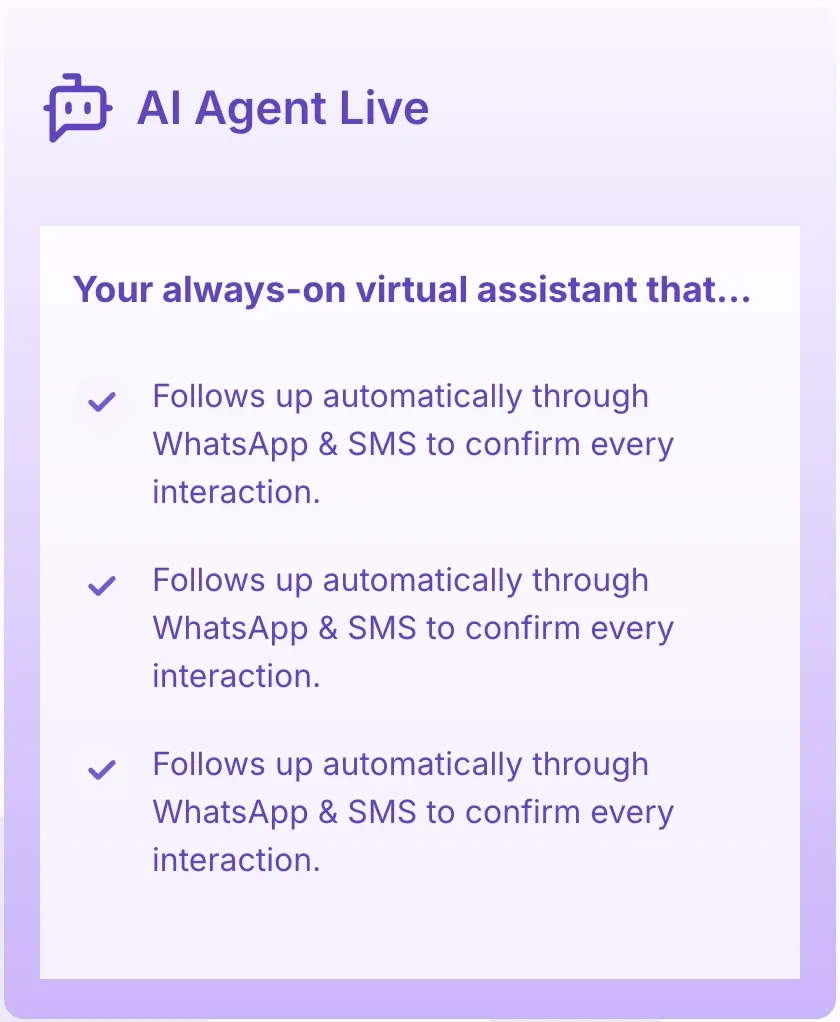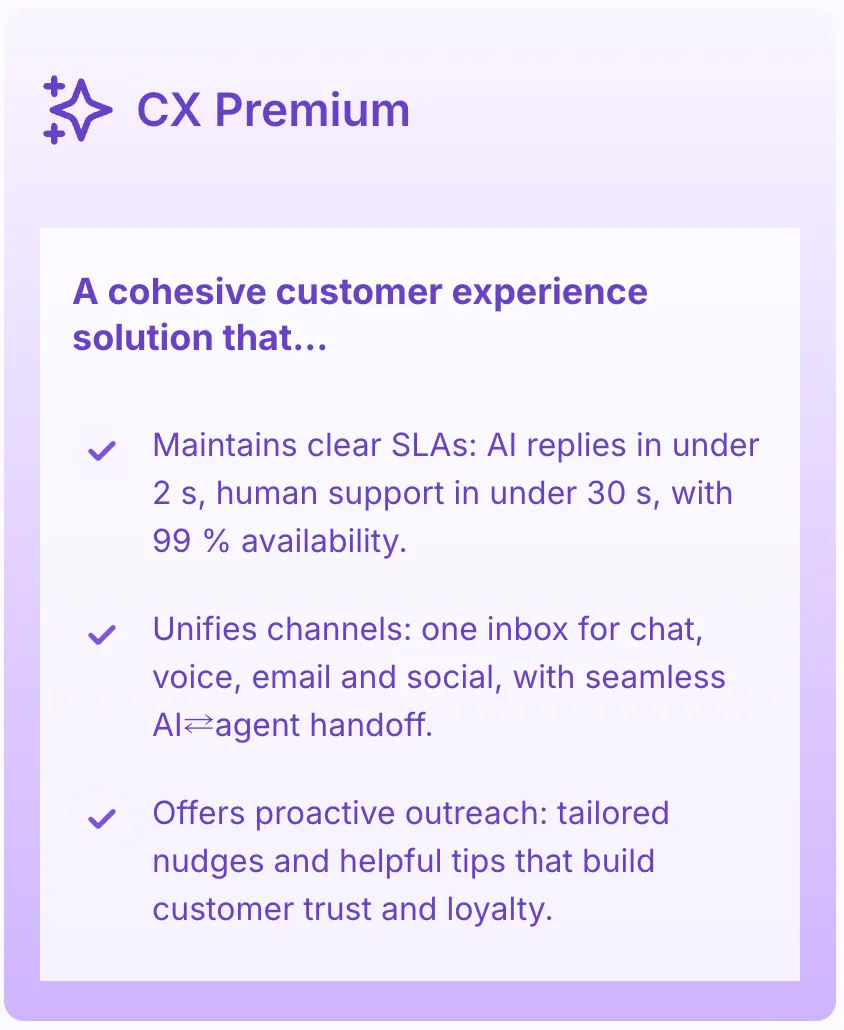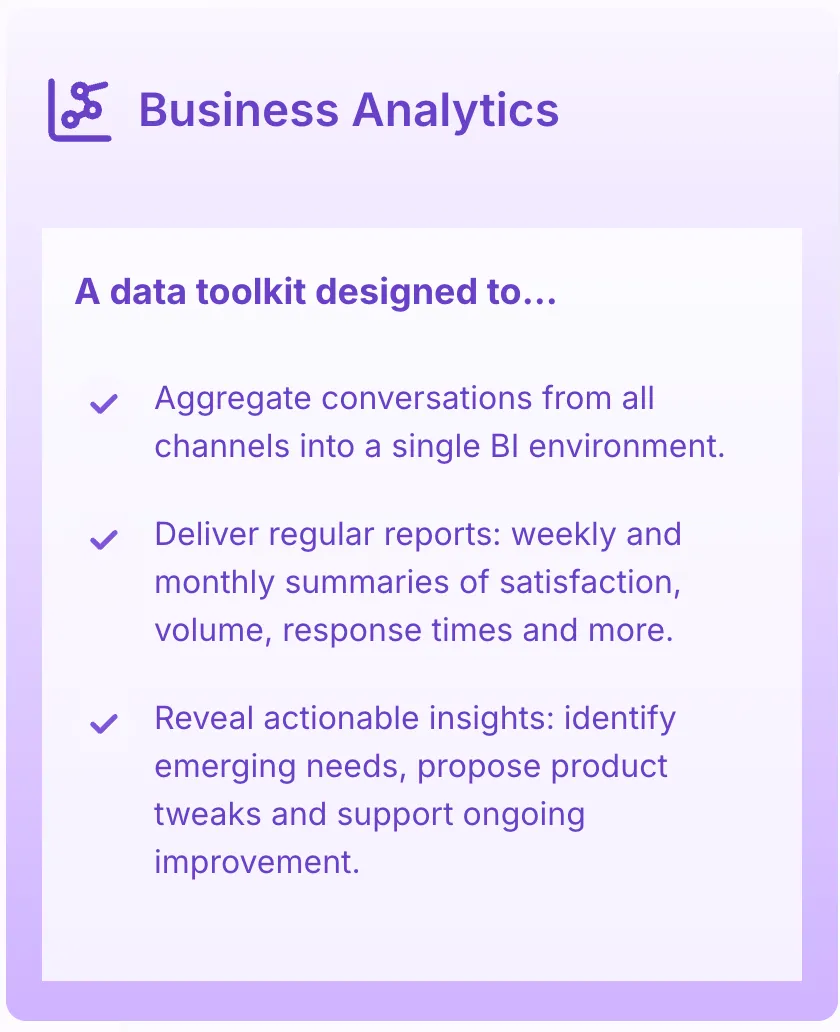Customer service encompasses the entire spectrum of customer interactions throughout their journey with your brand. It's about building relationships, fostering loyalty, and creating memorable experiences that keep customers coming back.
Customer support, on the other hand, focuses specifically on resolving technical issues and product-related challenges. Think of it as your specialized troubleshooting team, ready to tackle specific problems with practical solutions.
Understanding this distinction is crucial for businesses striving to excel in both areas. Companies that recognize and leverage the unique strengths of each function can:
- Create seamless customer experiences
- Build stronger customer relationships
- Deliver more effective solutions
- Drive higher customer satisfaction rates
- Increase customer loyalty
This article explores the nuances between customer service and customer support, diving deep into their responsibilities, goals, and collaborative potential to enhance your customer experience strategy.

Understanding Customer Service
Customer service represents a comprehensive approach that shapes every touchpoint in the customer journey. From the first interaction with your brand to post-purchase support, customer service creates a seamless experience that builds trust and fosters long-lasting relationships.
The Holistic Nature of Customer Service
Customer service encompasses various aspects of the customer journey, including:
- Pre-purchase guidance and product recommendations
- Order processing and delivery updates
- Post-purchase follow-ups
- Returns and exchanges handling
- Brand reputation management
- Social media engagement
- Customer feedback collection
Your customer service team acts as brand ambassadors, creating meaningful connections that transform one-time buyers into loyal advocates. These interactions build a strong foundation for customer retention through personalized experiences and proactive engagement.
Building Long-Term Customer Relationships
A robust customer service strategy focuses on:
- Understanding customer needs and preferences
- Anticipating potential issues before they arise
- Providing tailored solutions
- Maintaining consistent communication
- Creating memorable experiences
Empathy: The Heart of Customer Service
Exceptional customer service relies heavily on emotional intelligence and empathy. Your service representatives must:
- Listen actively to customer concerns
- Show genuine understanding
- Respond with appropriate emotion
- Adapt communication styles
- Take ownership of customer issues
Creating a Customer-Centric Culture
A successful customer service approach requires organization-wide commitment to:
- Regular training programs
- Clear service standards
- Employee empowerment
- Performance recognition
- Customer feedback integration
This customer-first mindset ensures every team member understands their role in delivering outstanding service. Companies that prioritize customer-centricity see increased satisfaction rates, higher retention, and stronger brand loyalty.
Your service teams need tools and resources to track customer interactions, measure satisfaction levels, and identify areas for improvement. This data-driven approach helps refine service strategies while maintaining the human touch that customers value.

The Focused Role of Customer Support
Customer support is your dedicated team for solving technical problems. They specialize in addressing specific challenges related to the product and its functionality. Their main goal is to quickly resolve any technical issues through expert assistance and troubleshooting.
Key Responsibilities of Customer Support Teams:
- Diagnosing and fixing technical problems
- Providing step-by-step guidance for product usage
- Handling software bugs and system errors
- Managing product updates and compatibility issues
- Documenting technical solutions for future reference
Modern customer support operates through multiple channels to meet users where they are:
- Help Desk PlatformsTicket management systems
- Knowledge base integration
- Issue tracking and escalation
- Direct Communication ChannelsLive chat support
- Email correspondence
- Phone support
- Remote assistance sessions
The technical nature of customer support requires specialized expertise and tools. Support teams use helpdesk software to track issues, maintain detailed documentation, and ensure consistent problem resolution. They focus on metrics like resolution time, first-contact resolution rates, and technical accuracy.
Unlike broader customer service functions, customer support zeroes in on specific technical challenges. While customer service might help you choose the right product or process a return, support teams tackle the nuts and bolts of making your product work as intended. They're the technical experts who understand product architecture, common failure points, and complex troubleshooting procedures.
Support teams often work with development teams to identify recurring issues and contribute to product improvements. This technical feedback loop helps companies enhance product reliability and user experience through systematic problem-solving and documentation.
Key Differences Between Customer Service and Customer Support
Customer service and customer support serve distinct purposes within an organization, each playing a crucial role in the customer experience landscape. Let's examine their key differences:
1. Scope and Approach
- Customer service encompasses the entire customer journey, from pre-purchase guidance to post-sale relationship building
- Customer support zeroes in on specific technical issues, product functionality, and immediate problem resolution
2. Primary Focus
- Customer Service:
- Building lasting relationships
- Enhancing brand perception
- Creating positive emotional connections
- Driving customer satisfaction across all touchpoints
- Customer Support:
- Resolving technical difficulties
- Answering product-specific questions
- Troubleshooting issues
- Providing step-by-step guidance
3. Success Metrics
- Customer service measures:
- Customer satisfaction scores
- Net Promoter Score (NPS)
- Customer retention rates
- Brand loyalty indicators
- Customer support tracks:
- Time to resolution
- First contact resolution rates
- Number of tickets resolved
- Technical issue resolution accuracy
4. Interaction Style
- Customer service adopts a relationship-focused approach, emphasizing empathy and personalization
- Customer support maintains a solution-oriented stance, prioritizing accuracy and efficiency in problem-solving
These distinctions shape how organizations structure their teams and develop strategies to meet customer needs effectively. Understanding these differences helps businesses allocate resources appropriately and deliver the right type of assistance at each customer touchpoint.

Leveraging Technology for Enhanced Service and Support Delivery
Modern technology is changing the way businesses provide customer service and support. With the help of AI-driven solutions, traditional methods are being transformed into scalable and efficient systems that benefit both companies and customers.
AI Chatbots: Your 24/7 Digital Assistants
AI chatbots handle routine customer inquiries with remarkable efficiency. These digital assistants can:
- Answer frequently asked questions instantly
- Process basic service requests
- Guide users through simple troubleshooting steps
- Collect initial customer information
- Direct complex cases to human agents
This automation allows your human support team to focus on challenging issues that require creative problem-solving and emotional intelligence.
Dynamic Automation Platforms (DAPs): The Integration Powerhouse
DAPs create seamless experiences across multiple communication channels:
- Live chat integration
- Social media messaging
- Email support
- Phone systems
- Mobile apps
The platform ensures consistent customer experiences regardless of the chosen contact method. DAPs analyze customer interaction patterns and automatically route inquiries to the most appropriate service channel.
Smart Queue Management
Advanced routing systems prioritize customer issues based on:
- Urgency level
- Customer history
- Issue complexity
- Available agent expertise
This intelligent distribution ensures faster resolution times and higher customer satisfaction rates.
Data-Driven Insights
Modern support technology captures valuable customer interaction data:
- Common pain points
- Peak service hours
- Customer preferences
- Resolution success rates
- Customer satisfaction metrics
These insights help businesses optimize their service strategies and predict future support needs. AI algorithms analyze patterns to suggest proactive solutions before issues escalate.
Personalization at Scale
Technology enables personalized support while maintaining efficiency:
- Custom response templates
- Automated follow-ups
- Personalized product recommendations
- Tailored self-service resources
This balance between automation and personalization creates efficient yet human-centered support experiences that drive customer satisfaction.
Strategies to Improve Quality Across Both Functions
Implementing effective strategies across customer service and support teams creates a unified approach to delivering exceptional customer experiences. Here's a comprehensive set of practical tips to enhance quality standards:
Staff Training and Development
- Implement regular product knowledge sessions
- Create role-playing scenarios for common customer interactions
- Develop empathy-building workshops
- Schedule cross-department training to understand different perspectives
Self-Service Resources
- Build a comprehensive knowledge base with FAQs
- Create video tutorials for common issues
- Design step-by-step guides for product features
- Maintain an updated troubleshooting database
Communication Channels
- Set up dedicated support lines for urgent issues
- Create specialized email addresses for different query types
- Enable live chat functionality on your website
- Establish social media response protocols
Quality Assurance Measures
- Record and review customer interactions
- Set clear performance metrics for both teams
- Create standardized response templates
- Implement peer review systems
Proactive Support Initiatives
- Send preventive maintenance reminders
- Alert customers about potential issues
- Share product updates and improvements
- Conduct regular check-ins with high-value clients
These strategies work together to create a robust support system that anticipates customer needs while maintaining high-quality service standards. Regular evaluation and adjustment of these practices ensure they remain effective and relevant to your customer base.
Continuous Improvement Through Feedback Loops And Data Analysis
Data-driven decision making is essential for providing exceptional customer service and support. By establishing effective feedback mechanisms, businesses can gain valuable insights into their customers' needs, pain points, and evolving expectations.
Key Methods for Gathering Customer Feedback:
- Post-interaction surveys
- Social media monitoring
- Customer interviews
- Product usage analytics
- Support ticket analysis
- Net Promoter Score (NPS) tracking
Turning Feedback into Action
Raw data needs proper analysis to drive meaningful improvements. Here's how businesses can effectively utilize customer feedback:
- Pattern Recognition: Identify recurring themes in customer complaints or requests
- Priority Assessment: Evaluate which issues impact the largest number of customers
- Root Cause Analysis: Dig deeper to understand the underlying causes of common problems
- Solution Development: Create targeted improvements based on customer insights
Social media monitoring tools help track brand mentions and sentiment across platforms. These real-time insights allow companies to address concerns quickly and adapt their service strategies based on customer preferences.
Measuring Impact
Track key metrics to assess the effectiveness of your improvements:
- Customer satisfaction scores
- Resolution time
- First contact resolution rate
- Customer effort score
- Retention rates
A Dynamic Automation Platform (DAP) can streamline this process by automatically collecting and analyzing customer feedback across multiple channels. This technology enables businesses to spot trends faster and implement improvements more efficiently.
Companies that consistently analyze customer feedback and adapt their processes accordingly create stronger connections with their audience. This data-driven approach ensures both customer service and support teams evolve alongside customer needs, delivering increasingly valuable experiences.

Enhancing Loyalty Via Personalized Experiences And Proactive Engagement Strategies
Building customer loyalty requires a strategic blend of personalized experiences and proactive engagement. Your customers expect tailored interactions that demonstrate you understand their unique needs and preferences.
Creating Personalized Customer Journeys
- Analyze purchase history to recommend relevant products
- Customize communication based on customer preferences
- Adapt service approach to match individual customer behaviors
- Design targeted promotional offers aligned with customer interests
Proactive engagement transforms standard service into exceptional experiences. When you anticipate customer needs before they arise, you demonstrate genuine care for their success. This approach includes:
- Sending automated order status updates
- Scheduling preventive maintenance reminders
- Alerting customers about potential issues before they escalate
- Following up after support interactions to ensure satisfaction
Data-Driven Personalization Strategies
- Track customer interactions across all touchpoints
- Use AI-powered analytics to identify behavior patterns
- Create detailed customer profiles for targeted engagement
- Implement dynamic content based on user preferences
The power of personalization extends beyond marketing - it shapes every customer interaction. When you combine detailed customer insights with proactive communication, you create meaningful connections that drive long-term loyalty.
Practical Implementation Steps:
- Map customer touchpoints
- Identify opportunities for personalization
- Deploy automated engagement tools
- Monitor customer response patterns
- Refine strategies based on performance data
Your proactive approach should extend throughout the entire customer lifecycle. This includes sending welcome messages to new customers, checking in during their product usage journey, and maintaining regular contact through personalized newsletters or updates.
Remember to maintain consistency in your personalization efforts across all channels. Whether customers interact through email, chat, or phone support, they should experience the same level of tailored service that reflects their relationship with your brand.
Conclusion
Understanding the difference between customer service and customer support is crucial for your business's success. Both functions are important - customer service focuses on building relationships, while customer support provides technical help.
To create exceptional customer experiences, your business needs both elements working together. When you invest strategically in these areas, you can expect:
- Higher customer satisfaction rates
- Stronger brand loyalty
- Reduced customer churn
- Sustainable business growth
The key is to understand how these functions work together. Customer support resolves immediate technical issues and provides insights to the customer service team. This data helps create personalized experiences and proactive engagement strategies.
Remember: Great customer experiences are not accidental. They come from intentional investment in both service and support capabilities, working as a unified system to exceed customer expectations and drive business success.
By prioritizing excellence in both areas, you can differentiate your business in today's competitive landscape.
FAQs (Frequently Asked Questions)
What is the key difference between customer service and customer support ?
Customer service encompasses every interaction a customer has with a company throughout their entire journey, focusing on building long-term relationships and fostering loyalty. In contrast, customer support specifically provides technical assistance and resolves product-related issues, concentrating on problem resolution rather than experience management.
Why is understanding the distinction between customer service and customer support important for businesses ?
Understanding this distinction helps businesses allocate resources effectively to provide exceptional service and support. Recognizing their interdependent roles enables organizations to enhance overall customer satisfaction, drive loyalty, and ensure consistent, high-quality interactions across all touchpoints.
How does empathy play a role in delivering excellent customer service ?
Empathy and emotional intelligence are crucial in customer service as they help create exceptional experiences that leave a lasting impact. By understanding and addressing customers' emotions and needs, companies can build trust, foster loyalty, and cultivate a customer-centric culture that values outstanding service.
What technological advancements can optimize both customer service and customer support ?
Technologies such as AI-driven chatbots can handle routine inquiries at scale, freeing human agents for complex cases requiring personalized attention. Dynamic Automation Platforms (DAPs) enable seamless integration across various communication channels like live chat and social media, ensuring customers receive consistent experiences regardless of how they reach out for help.
What strategies can businesses implement to improve quality across both customer service and support functions ?
Businesses should invest in comprehensive training programs covering product knowledge and empathy-building exercises. Embracing proactive approaches like creating self-service resources (FAQs) and establishing direct communication channels allows customers to easily reach out with concerns or feedback, enhancing overall quality standards.
How can continuous feedback loops and data analysis enhance customer service and support ?
Actively soliciting feedback through surveys, social media monitoring, and interviews allows businesses to refine existing processes and drive innovation. Staying attuned to evolving customer needs and preferences over time helps organizations improve satisfaction levels and adapt their offerings for sustained success.













